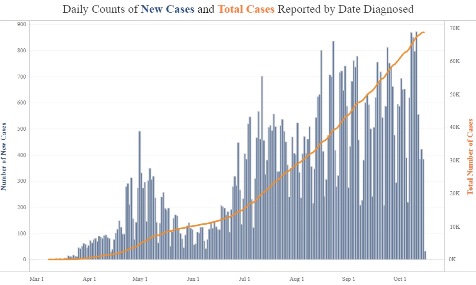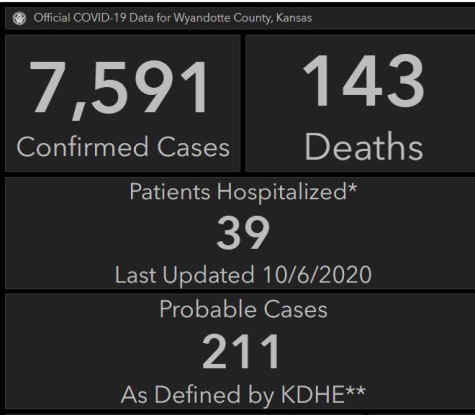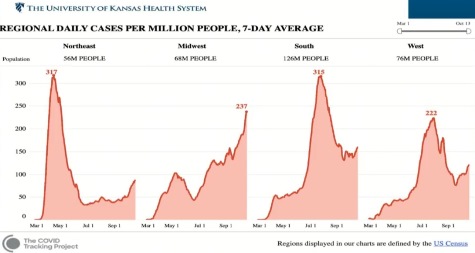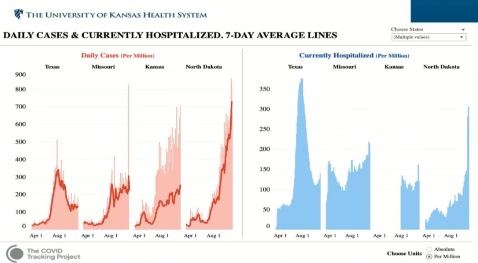

Kansas remains in the “red zone” for COVID-19 case numbers and also for deaths from COVID-19, according to Dr. Lee Norman, Kansas secretary of health.
Dr. Norman said the White House weekly report on Wednesday morning showed that Kansas had 164 cases per 100,000, compared to 100 casese per 100,000 for the United States as a whole.
Also, Kansas had 2.2 COVID-19 deaths per 100,000, compared to the national average of 1.5 per 100,000, he said at a news conference Wednesday afternoon. The average of the Federal Emergency Management Agency’s Region 7, including some Midwest states, was 2.9 deaths per 100,000, and Kansas is lower than that, he added.
Kansas also was in the “orange zone” for its positive test rate of 8.3 percent, compared to the national average of 5.8 percent, he said. Also, Kansas was in the “green zone” for lab testing at 1,952 per 100,000, compared to the U.S. average of 2,113 per 100,000, he said. Kansas performed better than Region 7 in the lab testing category.
Dr. Norman said Wyandotte, Sedgwick and Johnson counties together account for 35 percent of the new cases in the state. The rest of the new cases are in the other 102 counties, he said. The larger number of new rural cases has been going on for a few weeks now.
Dr. Norman said there were some mutated versions of COVID-19, and that there are now a few documented cases of people who have gotten it twice. In the future, perhaps a vaccine may contain protection against the different mutated versions.
However, Dr. Norman didn’t think they would see a COVID-19 vaccine released for the public before the end of this year.
As they continue to see an uptick in case numbers, everyone must remain vigilant, he said, and continue to wear masks, socially distance, wash hands and avoid gatherings. One of the most dangerous things are large groups of people gathering together closely without masks on, he said.
Since both flu and COVID-19 will be spreading this fall and into the winter, it’s important to get a flu vaccine, he said, as it will protect the person who gets it and also the community.
Kansas reported an increase of 1,293 COVID-19 cases on Wednesday, for a cumulative total of 69,155, according to Dr. Norman. There was an increase of 67 deaths for a cumulative 838, according to the KDHE.
Dr. Norman said 60 of these 67 deaths were identified through a death certificate and reports review by the Office of Vital Statistics. Typically patients die in hospitals, and their reports don’t always come back to the health departments immediately, he said.
Wyandotte County reported 7,591 cumulative COVID-19 cases, an increase of 66 since Tuesday, according to the Unified Government COVID-19 website. There was one additional death, for a cumulative total of 143. The UG’s percent positivity rate was 17.3 percent, according to the UG COVID-19 website. The seven-day rolling average of the percent positivity rate was 12.8 percent on Oct. 13, according to the UG COVID-19 website.
Dr. Dana Hawkinson, medical director of infection prevention and control at the University of Kansas Health System, said there were 26 COVID-19 inpatients Wednesday morning at KU Health System, a decrease from 30 on Tuesday, with seven in intensive care and six on the ventilator, the same number as Tuesday. There were 33 COVID-19 patients in the hospital in the recovery phase, an increase from 28 on Tuesday, he added. HaysMed in Hays, Kansas, had 18 active COVID-19 inpatients, which is high for the hospital, he said.


At a news conference Wednesday morning at the University of Kansas Health System, Dr. David Wild, vice president of performance improvement, said the Midwest has the highest rate of new COVID-19 cases in any region of the country, when adjusted for population.
COVID-19 is affecting smaller hospitals in Kansas, such as one in Pittsburg, Kansas, where they had so many COVID-19 patients that they closed other services, except for emergencies, he said.
Some of the smaller communities are not able to staff police and fire departments, and other essential services, because of quarantines, he said.
In general, the hospitals in the Kansas City area still have space for patients, although they have seen increases in the past weeks, but one or two of the hospitals in the smaller towns may be starting to fill up.
Dr. Wild said he believes the differences in the Midwest numbers and other regions have something to do with less mask-wearing and social distancing.
“Regionally, we have a lot of work to do,” he said.
Dr. Wild said the nation is in the upswing of a third wave. Whether it is a true surge that challenges the delivery of health care, they have yet to see, he added.
Health experts are concerned that the stair step of cases will lead to higher levels of new cases and new hospitalizations. Generally, hospitalizations follow cases. Data across seven months showed that as cases went up, hospitalizations went up, he said.
Dr. Wild showed a graphic of some Swiss cheese slices, with holes in them, that were in a line. He said it’s like trying to prevent COVID-19 with some imperfect methods. The slices represent wearing a face mask, socially distancing, washing your hands and rapid testing. Each layer is not perfect, but if you do each of the things, you can keep yourself safe, he said.
Dr. Hawkinson said trying to get herd immunity with COVID-19 is not a good idea. It was tried in Sweden and didn’t work.
Usually, the term means that 90 percent of the population have immunity based on prior infections or vaccinations.
Now, doctors are not sure that people can get herd immunity with COVID-19, as they are starting to see re-infections of people who have already had it once, he said. There is a tragic case of a woman who died from a second infection, he said.
Dr. Wild said they are not sure yet how long immunity would last after people are infected with COVID-19. When people get the common cold, they can get it again later that year or the year after, he said. It’s different with immunity from chicken pox, where the immunity lasts longer, according to Dr. Wild. When people are re-infected with COVID-19, they could get a version with different genomic sequences that they may not have immunity against, according to Dr. Wild.
Instead, health experts here are trying to test people with COVID-19 symptoms and isolate the ones who test positive, to prevent COVID-19 from spreading.
Dr. Hawkinson said they are seeing an unfortunate time now, with a surge or wave, and increases around the nation, including Kansas. It is starting to affect the work force and supply chain, he said.
Everyone needs to remain vigilant, avoid gatherings, distance, wear masks and practice good hygiene, he said.
“Don’t be gathering,” he said. At their program on Tuesday, a COVID-19 recovering patient talked about getting COVID-19 at a small gathering of friends watching a football game on television. People want to get together, he said, but they should be careful and continue practicing good hygiene, distancing and wearing masks.
He also mentioned a spin class in another state where 61 cases resulted, even though the class was doing everything for preventing COVID-19 that was recommended. The virus spreads efficiently, he said, and there is a risk in meeting in groups.
Free testing continues on Thursday
Free tests are available from 4 p.m. to 6 p.m. Thursday, Oct. 15, at Vibrant Health Argentine location, 1428 S. 32nd St., Kansas City, Kansas.
The tests are available through the Wyandotte County Health Equity Task Force and Vibrant Health.
Free tests also continue from 9 a.m. to 3 p.m. Monday to Friday at the UG Health Department, 619 Ann Ave., Kansas City, Kansas.
The tests now are open to asymptomatic people as well as those who have symptoms or have been exposed to COVID-19. Check with the UG Health Department’s Facebook page to see if there have been any changes in the schedule because of the weather or for other reasons.
Next week, the Health Department testing location is changing to the former Kmart parking lot at 78th and State.
More information about testing is at https://wyandotte-county-covid-19-hub-unifiedgov.hub.arcgis.com/pages/what-to-do-if-you-think-you-have-covid-19.
To view the KDHE news conference, visit https://www.facebook.com/KDHEnews/videos/746036159277701.
The KU doctors’ news conference is at https://www.facebook.com/kuhospital/videos/676613919653385/.
The KDHE’s COVID-19 webpage is at https://www.coronavirus.kdheks.gov/.
The UG COVID-19 webpage is at https://alpha.wycokck.org/Coronavirus-COVID-19-Information.
The Unified Government COVID-19 hub outbreak map at https://wyandotte-county-covid-19-hub-unifiedgov.hub.arcgis.com/.
To see an NEA list of schools that have had COVID-19 cases, visit https://app.smartsheet.com/b/publish?EQBCT=aa3f2ede7cb2415db943fdaf45866d2f.
The KC Region COVID-19 Hub dashboard is at https://marc2.org/covidhub/.
The CDC’s COVID-19 webpage is at https://www.cdc.gov/coronavirus/2019-nCoV/index.html.
